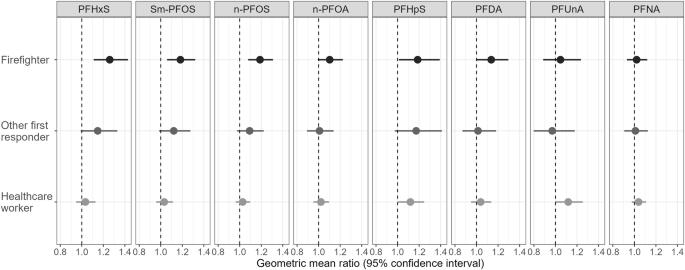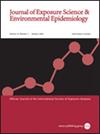Differences in serum concentrations of per-and polyfluoroalkyl substances by occupation among firefighters, other first responders, healthcare workers, and other essential workers in Arizona, 2020–2023
IF 4.7
3区 医学
Q2 ENVIRONMENTAL SCIENCES
Journal of Exposure Science and Environmental Epidemiology
Pub Date : 2025-03-06
DOI:10.1038/s41370-025-00753-7
引用次数: 0
Abstract
Certain occupations have greater risk for per- and polyfluoroalkyl substances (PFAS) exposure because of PFAS use in occupation-associated materials. We sought to assess whether PFAS concentrations differed by occupation among certain Arizona workers and whether concentrations differed over time by occupation. Serum concentrations for 14 PFAS were measured among 1960 Arizona Healthcare, Emergency Responder, and Other Essential Worker Study participants. Samples were collected at enrollment and periodically during July 2020–April 2023. Occupational categories included firefighters, other first responders, healthcare workers, and other essential workers. We fit multilevel regression models for each PFAS to estimate differences in geometric mean concentrations or odds of PFAS detection at enrollment by occupational category. For participants with ≥1 serum sample, we evaluated for yearly longitudinal differences in PFAS concentrations by occupational category. We used other essential workers for comparison, and adjusted for age, sex, race and ethnicity, year, and residential county. Adjusting for covariates, firefighters had higher perfluorohexanesulfonic acid (PFHxS), branched and linear perfluorooctanesulfonic acid (PFOS), and perfluoroheptanesulfonic acid (PFHpS) concentrations than other essential workers (geometric mean ratios 95% CIs: 1.26 [1.11–1.43]; 1.18 [1.06–1.32]; 1.19 [1.08–1.31]; and 1.19 [1.01–1.39], respectively). Healthcare workers had higher odds of detection of branched perfluorooctanoic acid (Sb-PFOA) and perfluorododecanoic acid (PFDoA) than other essential workers, adjusting for covariates (odds ratios 95% CIs: 1.35 [1.01–1.80]; 2.50 [1.17–5.34], respectively). During the 3-year study, we detected declines in PFAS concentrations among other essential workers; few longitudinal differences in concentrations by occupation were detected. Using data from a large prospective cohort of frontline workers in Arizona, we compared serum concentrations of 14 per-and polyfluoroalkyl substances (PFAS) among firefighters, other first responders, healthcare workers, and other frontline essential workers. We found that firefighters have higher concentrations of certain PFAS chemicals and the odds of detecting other PFAS chemicals are higher among healthcare workers compared with people in other occupations. Our findings highlight the importance of further action to reduce PFAS exposure within highly exposed occupational groups, such as firefighters, and the need to expand evaluation of exposure among other occupations, including healthcare workers.

2020-2023年亚利桑那州消防员、其他急救人员、医护人员和其他基本工作人员按职业划分的全氟烷基和多氟烷基物质血清浓度差异
背景:由于在与职业相关的材料中使用全氟烷基物质,某些职业接触全氟烷基物质和多氟烷基物质的风险更大。目的:我们试图评估某些亚利桑那州工人的PFAS浓度是否因职业而异,以及浓度是否随职业的时间而异。方法:在1960名亚利桑那州医疗保健、紧急救援人员和其他基本工作人员研究参与者中测量14种PFAS的血清浓度。在入组时和2020年7月至2023年4月期间定期采集样本。职业类别包括消防员、其他急救人员、医疗工作者和其他基本工作者。我们拟合了每个PFAS的多水平回归模型,以估计入组时不同职业类别PFAS检测的几何平均浓度或几率的差异。对于血清样本≥1份的参与者,我们按职业类别评估PFAS浓度的年度纵向差异。我们使用其他必要的工作人员进行比较,并根据年龄、性别、种族和民族、年份和居住县进行调整。结果:调整协变量后,消防员的全氟己磺酸(PFHxS)、支链型和线性型全氟辛烷磺酸(PFOS)和全氟庚烷磺酸(PFHpS)浓度高于其他必要工人(几何平均比值95% ci: 1.26 [1.11-1.43];1.18 (1.06 - -1.32);1.19 (1.08 - -1.31);和1.19[1.01-1.39])。经协变量调整后,卫生保健工作者检测支链全氟辛酸(Sb-PFOA)和全氟十二烷酸(PFDoA)的几率高于其他必要工作者(比值比95% ci: 1.35 [1.01-1.80];2.50[1.17-5.34])。在为期3年的研究中,我们发现其他基本工作人员的PFAS浓度有所下降;不同职业的浓度几乎没有纵向差异。影响声明:使用来自亚利桑那州一线工作人员的大型前瞻性队列数据,我们比较了消防员、其他急救人员、卫生保健工作者和其他一线基本工作人员的血清14氟烷基物质和多氟烷基物质(PFAS)浓度。我们发现,消防员体内某些PFAS化学物质的浓度较高,与其他职业的人相比,医护人员检测到其他PFAS化学物质的几率更高。我们的研究结果强调了进一步采取行动减少PFAS暴露在高度暴露的职业群体(如消防员)中的重要性,以及扩大其他职业(包括医护人员)暴露评估的必要性。
本文章由计算机程序翻译,如有差异,请以英文原文为准。
求助全文
约1分钟内获得全文
求助全文
来源期刊
CiteScore
8.90
自引率
6.70%
发文量
93
审稿时长
3 months
期刊介绍:
Journal of Exposure Science and Environmental Epidemiology (JESEE) aims to be the premier and authoritative source of information on advances in exposure science for professionals in a wide range of environmental and public health disciplines.
JESEE publishes original peer-reviewed research presenting significant advances in exposure science and exposure analysis, including development and application of the latest technologies for measuring exposures, and innovative computational approaches for translating novel data streams to characterize and predict exposures. The types of papers published in the research section of JESEE are original research articles, translation studies, and correspondence. Reported results should further understanding of the relationship between environmental exposure and human health, describe evaluated novel exposure science tools, or demonstrate potential of exposure science to enable decisions and actions that promote and protect human health.

 求助内容:
求助内容: 应助结果提醒方式:
应助结果提醒方式:


